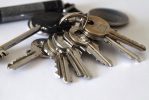| Hobie 16 |
My Hobie 16 is finally rigged up today. Everything seems to be there and working ok.
I store the mast separately on the ground where I can easily check all the standing riggings, stays, halyards and trapeze cables. There are two pairs of trapeze, one pair on each side, port and starboard.
| mast |
I used two of these for keeping the mast movement in one plane when raising/lowering the mast manually. The special pin assy ($34) helps to prevent accidents during this critical stage. The aluminium mast weighs 18 kg which is almost the maximum weight for me to handle alone. Even then I have rigged up a special pulley block used for raising the mast by myself.
| mast foot connector |
A small bolt and nut linkage connects the mast base to the mast seat (black). A rigging pin is inserted into one of the holes (marked 16). A round teflon bearing is inserted into the base before raising the mast.
| mast up |
The mast is raised manually and secured with a temporary fore stay until the jib is raised. The steel wire rigging stay is temporarily connected to the jib sheet via the blocks for raising the mast.
| mast foot |
When the mast is in the vertical position, the pin of the rigging connector is removed to check that the mast can rotate freely against its teflon bearing.
| jib |
The jib is raised and the clew of the sail is connected to the upper most hole of the jib adjuster, taking the strain from the temporary fore stay. The jib halyard is secured on the mast cleat #2
| rigged |
The main sail is raised and the halyard is secured on the mast cleat #1 in front of the mast. There is a small pulley block at the mast base for adjusting the halyard tensions of both sails. The main sail has 6 full battens; the jib has 3 battens. The mast is held up by three stays: two side stays and the larger steel wire sewn inside the jib leach becomes the fore stay. The rigging wire acting as a safety stay in case the jib halyard fails.
| luff tensioner |
The 3rd cleat on the mast is for tensioning the down haul, for keeping the luff tension in the main. There is also a foot tension adjuster at the outer end of the boom. The main sheet is connected to the traveller on the cross bar at the back of the trampoline. This arrangement is used for keeping both hulls on the water in light breeze condition. In stronger wind conditions, (when flying one hull) the traveller should be able to move freely to balance the boat! For this reason, it is wise to install a small buoy at the top of the mast. This will prevent the boat turning turtle in the sea. Then it would be very difficult to flip it back, especially for a single hander.
This boat has a special rigging underneath the trampoline use specially for un-capsizing the boat where necessary. Only Lake Taupo or the sea is deep enough for a Hobie to turn turtle. I have no immediate intentions to go there just yet; but when the top of the mast is poked inside thick mud in a shallow lake it could be tough to uncapsize this catamaran by myself. A special float is recommended at the top of the mast. Initially I intend to use the bladder from a 3 litre red wine pack!
| traveller |











No comments:
Post a Comment
Thank you very much for your visit and your comment.